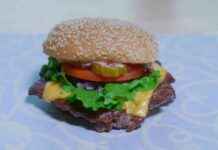recent years have seen multiple scandals, where honey has been illegally added sugar. And it is still mad, reveals the Consumer council Think today.
Coup – 16. feb. 2016 – pm. 16:21 Sorry from Netto, Føtex and Kiwi: We remove this bogus honey
According to the forbrugerorganisationens laboratory tests contain two of the tested honeys added sugar.
The case of Bigårdens organic acacia honey from China and the Green Balances the honey from the ‘non EU countries’.
Photo: Jacob Ehrbahn
According to the laboratory test results, it is beyond any doubt that the honey contains added sugar, says Hanne Damsted Vilsbøll, there is testchef at Forbrugerrådet Tænk.
– And since it is a known way to cheat, and there have previously been similar problems with the honey added sugar to the Danish market, we have notified the case to the Danish veterinary and food administration, she says.
But added sugar is not the only problem, as the test reveals.
the laboratory test results show that, respectively, an acacia and a heather honey contains too little pollen of acacia and heather.
The case of Søbogaard Acacia honey and Jakobsens European Heather Honey. The two products are, therefore, notified to the Danish veterinary and food administration for misleading marketing.
– Acacia and heather honey typically costs extra, and if the companies should sell their honey as, for example, acacia honey, so a larger part of the pollenindholdet come from akacieblomster. It is not the case here, where the content of the akaciepollen is under 10 percent, and thus consumers, in our opinion misled, says Hanne Damsted Vilsbøll.
the Best of the 14 tested honeys, is ‘English Honey’ from the beekeeper Knud Hvam.
It is also the only honey in the test, which comes from a Danish beekeeper.
the Best of the 14 tested honeys, Danish Honey from the beekeeper Knud Hvam. Photo: Jacob Ehrbahn
the Whole test can be found in the new issue of the magazine Consumer Think and think.dk.
Rejects problems
It is the company Good Food Group, who import the Apiary organic acacia honey, and their external analysis of the honey from the accredited laboratory to show that there is no added sugar, foreign enzymes or another.
Good Food Group say that the inquiry whether the test is treated with the utmost seriousness, as the Good Food Group wants to deliver a good product to their customers and consumers. Good Food Group has therefore contacted the Fda and asked them to review the current case and the company’s checker.
Karin Frøidt, koncernkvalitetschef in both cases, which stands for Green Balance Organic Honey, says that the company is purchasing pure honey and crack down hard, if there are teams in the appearance of added sugar.
According to Karin Frøidt have Dagrofa not even in their analysis found indications of added sugar. Honningerne be analysed with the method, the NMR, which the Fda uses, and in addition, shall also random with different methods of analysis.
Karin Frøidt tells that both cases do not use the method, as the Consumer council Think has been tested since it has been shown that different laboratories reach different results when applying the method in exactly the same honningprøve.
Dagrofa will examine more closely what it is that has given rise to this result, as the company does not accept the added sugar in their honey.
Søbogaard importer, says that even if the test shows a low pollenindhold from acacia, they believe that it is obvious from the color, the look, the smell and the taste can see that there is talk of acacia honey.
Quality manager Martin Pedersen from Jakobsens believe that the honey meets the requirements, that is for to call it a heather honey.
project Manager Peter Skjødt of the Danish Consumer council Think that has stood to the test says that the laboratory’s conclusion is quite clear, and that lynghonningen from Jakobsens not be called heather honey, but instead should be called to blossom with heather.
Food – 16. feb. 2016 – pm. 13:12 Fierce criticism of Kjer and food industry in the honey-case








